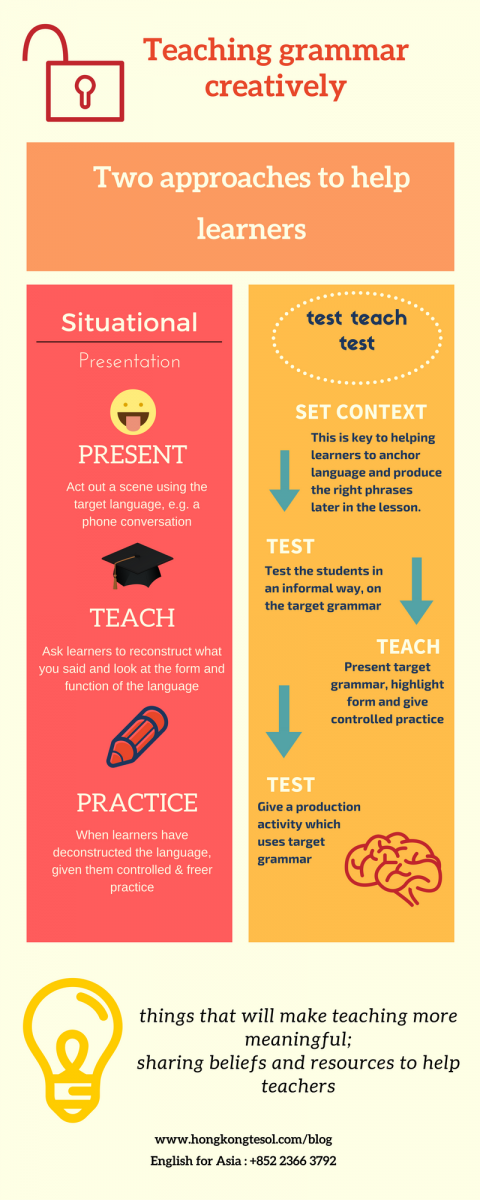30th August 2016
A few weeks ago we introduced you to the basic principles of how to teach grammar. The key idea behind the basics of teaching grammar relies setting a clear context, introducing the target form and then providing practice and production opportunities for your students. This week we look at some alternative ways to deliver grammar lessons - some which you may be familiar with, some of which you may not. Why not try some out and see how you and your students respond? This is part 1 of our How to teach grammar creatively series, so be sure to watch out for part 2 in the coming weeks.
Test Teach Test

A TTT approach to your grammar lesson might be an advantage in a number of ways. Firstly, unlike a more traditional PPP style, which assumes that you are showing the learners a piece of language for the first time, TTT allows you to see how much the learners know, before deciding which language and how much language to introduce. Secondly, it gets the learners active and producing language immediately, which means you’re less likely to get bogged down in lengthy context-setting, vocabulary explanations or teacher-led grammar presentations.
So here’s a brief run down of a lesson on “I wish” and “If only” to talk about regrets:
First, set context
Show students a picture on the board of someone thinking. Elicit what they might be thinking about. For this lesson, we’ll be using the target phrases to talk about past regrets, so you might add a picture to show this person thinking about a classroom, or some books, or an ex girlfriend or boyfriend and establish they are thinking about the past (you might ask "Do you think this is happening tomorrow, now or in the past?"), and that they are thinking negative things, or something that they wish was different in the past. These concepts are key to producing the right phrases later in the lesson.
Second, Test the students (Test #1)
Now ask students to write one or two sentences on a strip of paper to describe what this person is thinking about. Perhaps ask students to write these starting with “I....”.
Teach
Collect the students' papers and read some of them out. It’s important here to acknowledge what the students have done. Focus more on whether or not the meaning of the sentences is clear rather than accuracy of the language.
As a teacher you have a choice here: some of the students may have produced suitable forms, or close approximations, but some may not. In the case where nobody has written the correct form, read through a couple of examples, board them and then read a few more correct examples of your own (I usually have a few planned in advance) and board them next to the student ones that have a few mistakes in them: e.g. I wish I went to piano classes when I was at school vs I wish I had spent more time with my brother before he moved overseas.
So now you have some of the student sentences that are incorrect, and some good examples of language on the board (which are either yours or your students’) and this gives you the chance to check meaning: Is this person talking about the past or the present? Is this person thinking about something that did happen or didn’t happen? Does this person feel happy that it didn’t happen? Etc. Then you can highlight the form: I wish + I + had + p.p, or if only I + had + pp. And of course, lots of drilling.
One idea that works really well is to drill the correct phrases before you put them on the board (i.e. at the beginning of the 'teach' stage) to focus students on the pronunciation before they see the written form. This can make the intricacies of reduced and contracted forms a little clearer when the forms are written down.
Be aware here, that you might also get students trying to write things like I regret not to go to swimming classes or It makes me sad that I don’t spend time with my Brother. These are of course legitimate attempts at alternative phrases for the same function: I regret (not) going, or It makes me sad that I went/didn’t go etc. It’s really important to be aware of other possibilities here, and give students the chance to use the language they are trying to use rather than force them to conform to your pre-determined language agenda – so be prepared with a few different marker sentences before you go into your “teach” stage.
Give them some controlled practice
As you’ve already got a few erroneous examples from students on the board, you can now ask the group to correct their own sentences, either on the board, or by redistributing the strips of paper from the beginning. Have students peer-check each other, and possibly write one or two more of their own sentences using a range of phrases from the board.
Production (Test 2)
Now see if the students can use the language again. You could either rub the language off the board, or hide certain words from the marker sentences, or give the students a communicative task using some pictures of common life events (studying music, learning to swim, moving abroad, learning English) and have them discuss these pictures in groups by asking each other something they regret about each situation.
Situational Presentation
Situation Presentation allows you very clearly demonstrate the usage of key language in context. When I first started experimenting with this, I used to leave my classroom as students were busy checking their homework from the previous day, and then burst back in with a panicked look on my face as I explained to the students that there had been a robbery and a man with a gun had just come in to the school….then I moved to Colombia to teach and realized it probably wasn’t the most sensitive idea.
However, there are many other options and choices for this approach. The following is an outline for contrasting the use present continuous and present simple, mainly to talk about the future.
Present
As students are working on a task, or as one task comes to an end (I would normally do this early in the lesson, so, after homework has been checked for example), I pretend to answer my phone. There is a certain amount of performance involved in this, of course – if you just pull out your phone and answer it, the effect will be minimal and students might not even notice what you’re doing! So, start by suddenly looking very embarrassed, looking nervously from side to side. Then as you pull out your phone, let out a big sigh, and look up at the class, and back at your phone again….take a second before admitting to the students that it’s your mum, and she’s a bit old and not well….would they mind if you very quickly spoke to her? In fact this little performance is more likely to hold their attention – I have tried this before without such a preamble, and I found most of my students then just started talking to each other as I was “talking” on the phone (to myself!).
As you put the phone up to your ear, pretend you’re having a conversation….something along these lines:
Hi…yes hi Mum. No…no I’m in class. Yes, I know…no I’m teaching at the moment. Yes, real students…No, they’re all very friendly. No. No. No….this weekend? Mum! Really? I told you already….I’m having dinner with Kate on Saturday. No…no not really, I can’t because I’m supposed to be taking her out for her Birthday. No, then we’re going to the park with her sister. No mum…no…On Sunday? That won’t work either. No…the Dentist doesn’t work on Sunday, Mum…you’ll have to try on Monday….ok…I’ve gotta go..ok mum..ok…bye…bye…yes mum…bye…byyyyyeee…
I would suggest that you don’t script this as it is more likely to come across as natural and the language you use is likely to be more interesting – though this comes with the challenge of you needing to be aware of what you are saying and remembering this carefully, so it’s well worth practising a few times first.
Teach
So immediately after students hear your conversation, you might look up at them with a cheeky smile on your face and ask them if they understood what the problem was. I normally at this point ask them to stop what they are doing and write down everything they remember. They may protest, but encourage them to try, and to help each other. Then I ask them if they’d like to listen to the conversation again, at which point I’ll enact my phone exchange once more, and have them check what they wrote down the first time.
Then we write up some of the key sentences from the text. In this case, it would be things like:
I’m having dinner with Kate on Saturday - future plan
I’m teaching at the moment - present action in progress
I’m in class - current state
Dentist doesn’t work on Sunday - routine
This may take a bit of reformulation of what the students suggest, or you may wish to check their basic understanding of the text first with questions like “What are my plans on Saturday?” or “What does the Denstist do on Sunday?” and “Where did the conversation happen?”.
The marker sentences above can be then put up on the board and the uses of present continuous and present simple can be contrasted for meaning and form.
Practice
Once this has been done, you might have the students then write their own dialogue on the phone. You could provide additional support for this by providing a few prompts for them to work with, such as: dinner on Friday, at the park now, trying to finish your assignment, at the supermarket, looking for a present for your brother.
And of course, once this has been done you can move on to helping the students put this into use by role playing conversations with difficult relatives. This might require role cards, or blank diary templates for the students to fill in – there are some good activities like this in Elementary Communication Games that you could easily adapt.



